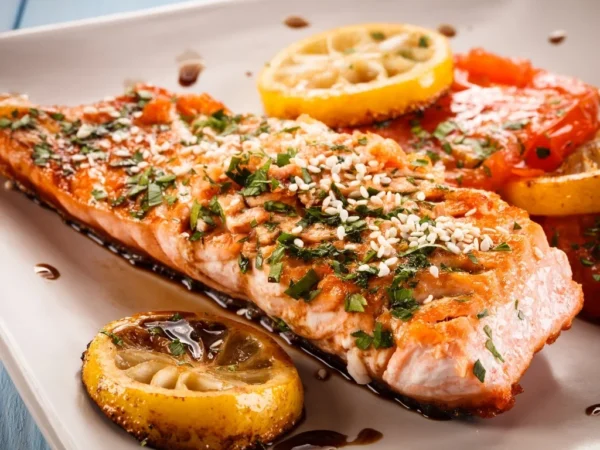It’s a myth that we have to choose between health and pleasure — that the foods we love aren’t compatible with good health. But enjoying a slice of birthday cake at a party with friends is as integral to our health as eating grain bowls and leafy green salads. We have social and emotional lives that need as much nourishment as our physical bodies.
Eating for this whole self can be a challenge if we don’t make space for balance, flexibility, and self-compassion in our diets. It might require that we unlearn rigid food rules or reframe thoughts of food as either good or bad. It also requires tuning into the connection between our mind and body throughout the day, especially at mealtime. If this process seems all too overwhelming or impossible, let the following principles guide you.

Allow All the Foods You Enjoy
You have permission to eat food that tastes good and makes you feel good. Sometimes that’s fruits and vegetables, and sometimes it’s a bowl of ice cream after dinner. Allowing the full range of foods that give you pleasure is necessary to create balance and avoid chaotic eating.
Restricting the foods we love can exacerbate our desire for them and lead to obsession, guilt, cravings, and overeating. Studies show that food restraint, and the accompanying sense of deprivation, increases a person’s risk for developing unhealthy eating behaviors, negative body image, anxiety, and depression. It can also predict future weight gain. A more flexible approach to eating is associated with healthier attitudes, behaviors, and weight.
Rather than moralizing or demonizing certain foods, explore how different foods can serve different parts of your health. Understand that how you eat over time is what matters most; one indulgent meal will not derail your health!
Honor Your Hunger and Fullness
Intuitive eating is gaining recognition as a more personally sustainable alternative to dieting. It encompasses several principles, one of which directs people to listen to their body’s hunger and fullness cues.
It’s not always as straightforward as eating when you’re hungry and stopping when you’re full. Stress can mute our body’s sense of hunger, and we might not trust ourselves to stop when we’re full. This is all normal and okay. Start by checking in with your body throughout the day. If your stomach is rumbling or you can’t stop thinking about food, that’s probably your cue to eat. If it’s past lunchtime and you haven’t eaten all day, yet you don’t feel hungry, consider eating a small snack to avoid overeating later.
As you eat, try to eat slowly so you can taste and appreciate your food. Pay attention to the early signs of fullness. Eat until you’re satisfied but not uncomfortably full. Don’t be too hard on yourself if you do overeat; it could be your body’s natural mechanism to get the energy it needs for basic functions.
Be Flexible
This principle goes hand-in-hand with allowing all foods, but it goes further to acknowledge that we’re not always in control of our food environments or food preparation methods. Holidays, social gatherings, and eating at restaurants require flexibility. Holidays are especially challenging with the abundance of food at the table and preemptive warnings not to overindulge.
In these situations, food takes on social, cultural, and psychological value. Instead of avoiding or fearing these situations, lean into the opportunity to feed your social and emotional well-being and anticipate the pleasure to come. In fact, a 2016 study from the University of British Columbia showed that people who anticipated the smell, taste, and texture of a food prior to eating it actually chose smaller portion sizes.
Make Space for Nutrition
While it’s important to allow all foods, we also need to give our bodies enough food and nutrients to avoid the consequences of malnutrition. This doesn’t mean throwing pleasure out the window. Choose nourishing foods that align with your taste preferences. Consider the following tips as you fit nutrition into your self-care routine:
- Aim for three meals and a couple of high-energy snacks throughout the day, like nuts, carrots, hard-boiled eggs, canned tuna, and dark chocolate.
- Eat a variety of foods from all of the food groups (fruits, vegetables, proteins, grains, and dairy).
- Make your meals as colorful as possible. Fruits and vegetables use their colorful exteriors to indicate the presence of vitamins, minerals, and other beneficial nutrients. The more color you eat, the greater range of nutrients your body gets.
- Eat fiber-rich foods like fruits, vegetables, avocado, whole grains, beans, and nuts.
- Incorporate foods with fat, carbohydrates, and protein. This will keep you full and satisfied for longer.
Always remember there is more than one path to eating for good health. Explore what it means to be healthy and well by your standards and intuition.
If you have more questions about how your food affects your well-being or how you can improve your relationship with food, you can call (312) 374-5399 or schedule an appointment online to talk with one of our registered dietitians.
Submitted by Emily Guzman
Edited by Alex Franz
Reviewed by Morgan Murdock

References
- 10 principles of intuitive eating. (n.d.). Retrieved from https://www.intuitiveeating.org/10-principles-of-intuitive-eating/
- Bacon, L., & Aphramor, L. (2011). Weight science: Evaluating the evidence for a paradigm shift. Nutrition Journal, 10, 9. doi:10.1186/1475-2891-10-9
- Cornil, Y., & Chandon, P. (2016). Pleasure as a substitute for size: How multisensory imagery can make people happier with smaller food portions. Journal of Marketing Research, 53(5), 847-864. doi:10.1509/jmr.14.0299
- Duarte, C., Ferreira, C., Pinto-Gouveia, J., Trindade, I. A., & Martinho, A. (2017). What makes dietary restraint problematic? Development and validation of the inflexible eating questionnaire. Appetite, 114, 146-154. doi:10.1016/j.appet.2017.03.034
- Evers, C., Dingemans, A., Junghans, A. F., & Boevé, A. (2018). Feeling bad or feeling good, does emotion affect your consumption of food? A meta-analysis of the experimental evidence. Neuroscience and Biobehavioral Reviews, 92, 195-208. doi:10.1016/j.neubiorev.2018.05.028
- Linardon, J., & Mitchell, S. (2017). Rigid dietary control, flexible dietary control, and intuitive eating: Evidence for their differential relationship to disordered eating and body image concerns. Eating Behaviors, 26, 16-22. doi:10.1016/j.eatbeh.2017.01.008













